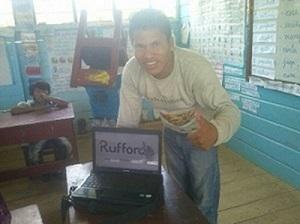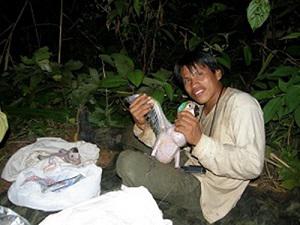Braulio Poje Mishaja
The Native Community of Infierno consists of the largest Ese’eja ethnic group in the south-eastern Peruvian Amazon. Some people still hunt macaws in their territory for food and feathers, causing a continuing threat to them. This project aims to teach local people about the importance of conservation via practical hands-on field studies.

The main objective of this study is to conduct a comprehensive parrot census in the native territory of the Infierno Community. This census would be the first step towards the conservation of these birds in this area. The native land could be the last refuge of the parrots between the Tambopata National Reserve and Puerto Maldonado town. It is important to study the effect of human disturbances (e.g. close vicinity of an urban area and highway) on parrot populations, but we need to provide baseline census data first.

Braulio Poje and macaw chicks.
We also want to document the number and location of nest hollows in the native territory to enable their study and protection. GPS marking of nests and large over-story trees will serve as a digital map of the area for further studies and can be the first step to protect these trees from selective logging.
This study also aims to monitor nest hollows of parrots and macaws in the land of the community. Occupancy of the different nest sites can be confirmed by climbing up the trees. Occupied nests will be monitored with the help of young people from the community.
This project aims to teach local people about the importance of conservation via practical hands-on field studies to preserve the biodiversity on their own lands. This way they can take part in and benefit more from sustainable ecotourism. The project will be carried out with the help of young people from the community. Conservation education and talks about this study are also planned in the local school.